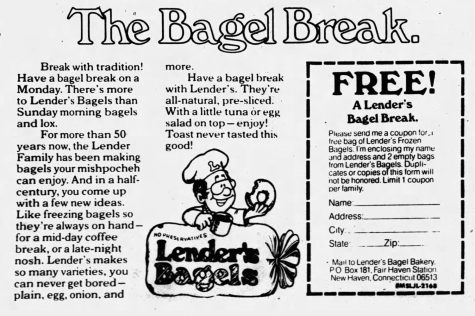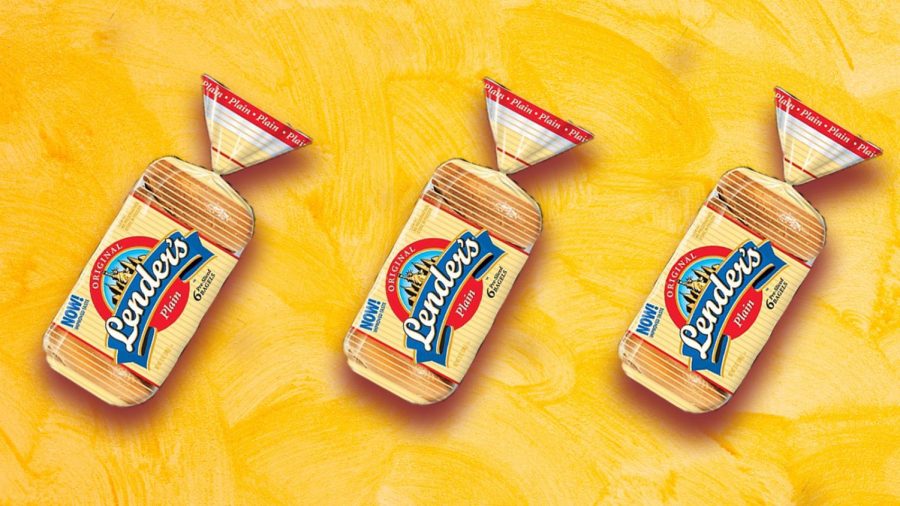The Jewish history of Lender’s bagels
Published January 15, 2023
Over the last decade, bagels have ascended to a realm of culinary importance and controversy that rivals that of pizza or even barbecue, with heated debates over what makes the chewy, round, yeast-leavened bread so special. Is it the water? Malt in the dough? Team Montreal or New York? But 100 years ago, there were no such quibbles. The bagel, brought to the U.S. by Polish immigrants and sold, six on a string, by street peddlers with push carts, was almost exclusively a product of and for the Jewish community.
RELATED: The Ultimate Guide to St. Louis Homemade Bagels
In the summer of 1927, Harry Lender, a Jewish baker from Chelm, Poland, escaping rising antisemitism in Europe and seeking a better life for his family, arrived on the SS Pennland at Ellis Island. Lender worked at a bakery in Passaic, New Jersey to earn enough money to bring his wife, Rose, and their children over from Poland. In under a year, he had earned enough to buy a bakery in New Haven, Connecticut and a year later, had amassed enough to arrange for his family’s trip across the Atlantic.
With their family reunited, the Lenders moved from the bustling commercial corridor of Oak Street to a home bakery on Baldwin Street. There, over the next thirty years, Harry Lender baked hand-rolled bagels in a coal-fired oven at the back of the property under the geographically perplexing name New York Bagel Bakery.
After Lender succumbed to pancreatic cancer in 1958, his sons, Hyman, Sam, Murray and Marvin, took over the business, renaming it H. Lender’s and Sons; but after a short time, Hyman left the business and eventually Murray, who acted as CEO, and Marvin, the company’s president, bought out Sam, establishing the partnership that would endure for the remainder of the the company’s history until its sale to Kraft Foods in 1985.
Murray and Marvin were on a mission to “bagelize” America by bringing the then-ethnic food into the mainstream. Growth for Lenders was quick and steady. Outgrowing their home bakery, they opened their first production facility in 1965, which doubled in size in its first year. Thanks to automation, Lender’s was able to produce millions of bagels each year, but with a notoriously short shelf life, the bagels couldn’t last long enough to sell fresh to the public.
Since the mid-fifties, the Lenders had been tinkering with freezing bagels throughout the week to thaw and sell fresh on Sundays, when demand was the highest. They also sold frozen bagels to the famed Catskill’s resort Grossinger’s and to the U.S. Army. But never before had the wholesale operation sold frozen bagels to the public — nor had anyone else. “When we decided to make the move and do frozen, frozen foods were just coming alive,” Marvin Lender recalls. Inspired by Sara Lee founder Charles Lupin, who had just released a line of frozen cheesecakes, Lender says, “Murray and I looked at each other and said, ‘If Charlie can freeze a cheesecake, we can freeze a bagel.’” From that moment on, they were focused on the frozen food space, with Murray serving as chairman of the National Frozen Food Association and pioneering the first National Frozen Food Month in March of 1984.

Lender’s was selling more than a breakfast food; they were selling themselves. Working with Willie Evans, the in-house artist who illustrated Lender’s most memorable advertisements, they introduced The Lenders Men —Murray, Marvin and Sam — bringing the family right into people’s homes. Often, advertisements would include the personal touch of being “signed” by Murray, the face of Lender’s Bagels, who was said to never go into a meeting without a bag of bagels under his arm.
During this period of exponential growth, Lender’s became known for innovation, introducing pre-sliced frozen bagels, a huge logistical undertaking but one that anyone who’s tried to slice a bagel before drinking their morning coffee can appreciate. Later, in an effort to reach an ever expanding audience, Lender’s introduced flavors like onion, egg and raisin-honey. “I remember when we made raisin and honey bagels, I said to Murray, ‘Our father is turning over in his grave,’” says Lender. “A raisin and honey bagel? Unheard of! But we sold a ton of them. It reached a lot of people.”
Throughout the 70s and early 80s, Lender’s continued to gain market share thanks in large part to their playful and clever advertising. Cross-couponing, the practice of including a coupon for bagels in complementary products like Philadelphia Cream Cheese and Fleishman’s Margarine and vice versa, opened new doors for Lenders. As did buying ad space during “The Tonight Show With Johnny Carson,” a move that Marvin recalls costing “a small fortune” that paid off big time, with Murray appearing on the show in 1977 and presenting a “Bagel Finagle,” a frieze of bagel heads made to look like Carson and guests, designed by Willie Evans. Soon, every celebrity wanted a bagel head, and most of them, from Harry Belafonte to Roy Clark, got one.
After growing the business to its zenith, Murray and Marvin found a buyer in Kraft Foods and in typical Lender’s fashion, they turned the merger into a marketing opportunity, framing it as “The Wedding of the Century” between ‘Len’ the Bagel and ‘Phyl’ Philadelphia Cream Cheese. The move showed that, though the business was no longer family-owned, it would continue to honor the wit and humor the brand was known for.
With the sale behind them, the Lender’s brothers focused on a variety of charitable causes, echoing the lessons they learned from Harry Lender. “We learned a lot from our father about values,” says Marvin. In the days on Baldwin Ave, Marvin recalls delivering bagels to area nonprofits on Thanksgiving. They didn’t have much money back then, but they had bagels, so that’s what they gave. “That’s the mentality of people who are children of immigrants into America, where this opportunity was provided that you couldn’t get anyplace else in the world. We knew that, we appreciated that, and as a result, when we sold the business, we went into the business of philanthropy.”
Now that America is fully bagelized, frozen bagels are quickly dismissed by connoisseurs, but without the work of the Lenders, these modern advances in bageldom (Sourdough bagels! Rainbow bagels! A shop on every corner!) would never have been possible. They paved the way for the golden age of bagel consumption we enjoy today. But some things haven’t changed: From his home in Florida, Marvin Lender, now 80, still enjoys a bagel for breakfast — plain, toasted, with a schmear of cream cheese. Perfect.















